Christmas Belles: A Turkey for Christmas
Photo: Andrew Kenneth Martin.
HAMLET (solo) is a one-man play created by featured actor Raoul Bhaneja and director Robert Ross Parker. It’s a slightly truncated version of Shakespeare’s HAMLET in which Mr. Bhaneja, plays, or rather indicates, all seventeen characters. Working on a bare flat stage surrounded by black drapes and using no props, Mr. Bhaneja wears a simple black long-sleeved tee-shirt and black jeans. The lighting is utilitarian and the house lights are only dimmed to half, so the actor is clearly visible when he moves into the audience.
First let me say that if you’re not pretty familiar with HAMLET, despite the detailed synopsis in the program, you’ll find it confusing. It does provide an ego boost for those in the audience who clearly follow it. Mr. Bhaneja is physically very facile and uses primarily body language to delineate the characters. However in playing all seventeen roles the emotion and depth of the original characters is lost. We’re left with hollow physicalizations. Granted it’s quite a feat of memorization, but so is any solo show. Think, for example, of I AM MY OWN WIFE, A THOUSAND EYES and the work of Pierre Brault. These are solo pieces that present many characters, but with great depth.

When seeing Shakespeare’s works performed, we just as often go for the spectacle as for the language and poetry. We’re used to seeing multiple costume and set changes and the idea of taking away this display, especially one as seminal as Hamlet, is a great risk and can easily end up leaving the audience disconcerted and bored. Yet, this is precisely the risk actor Raoul Bhaneja and director Robert Ross Parker take in their minimalist take on the play. Bhaneja takes on the gargantuan task of performing all 17 characters in this one man show. It is a testament to both his and Parker’s skill that the production is so fresh and captivating. It is sometimes hard to differentiate the different characters, especially for those not as familiar with the play. However, this happens rarely and, overall, Bhaneja does a wonderful job transforming from one character to the next.
Bhaneja, dressed in all black on a black, empty stage, walks toward the audience, whistling and recreating the cold, blustery opening scene of the famous play. From that moment, it’s easy to get swept up in the action. Each character shines through and the production is choreographed down to the smallest detail, all to great effect. Bhaneja’s performance is mesmerizing and his delivery is fast-paced and modern, all without losing any of Shakespeare’s poetry or linguistic nuance. The team has also very wisely decided to use accents sparingly, which is refreshing and allows the audience to focus on the meaning versus just the delivery. …
Raoul Bhaneja performs Hamlet. Photo: Andrew Kenneth Martin.
OTTAWA — To tinker or not to tinker, that’s the … well, actually, it’s not a question at all. Anyone who’s going to play Hamlet – and who wouldn’t want to, considering the extraordinary palette of character and situation William Shakespeare has bequeathed us with this play? — has to experiment with the role if he’s to make it his own.
Raoul Bhaneja takes the making to a whole different level by playing all 17 characters, including the title role, himself in this slightly slimmed-down version of Shakespeare’s great tragedy.
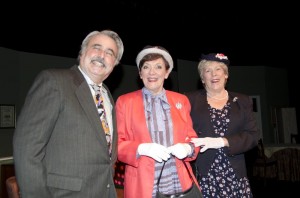
The Last of Jane Austen
By Shirl Hendryx
Phoenix Players
Appropriate pastimes for elderly ladies are attending readings of Jane Austen’s works at their church and playing quiet games of Canasta at home. But, when the sisters Stevenson become bored with such genteel behaviour and enamoured with the fine art of boxing, their world changes — especially when a needy young man knocks on their door and begs for work.
Finding a photograph of him in boxing mode is all the prompting Sarah and Margaret Stevenson require to go into the boxing business as his trainers/managers.
Such a fairy tale premise makes a believable production extremely difficult. In the Phoenix Players’ version of The Last of Jane Austen, director Jo-Ann McCabe and her cast try very hard to inject some credibility into the show, but they are fighting a losing battle. …
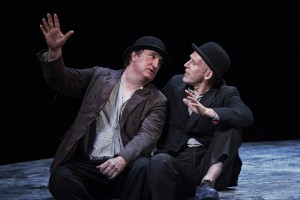
Samuel Beckett’s Waiting for Godot premiered sixty years ago as En attendant Godot in a small, run-down theater in Paris. Despite the play’s lack of traditional structure – exposition, story development, action, climax, and dénouement – opening night reviews were enthusiastic and the production ran for a hundred performances. Beckett translated and adapted it into English, Irish English at that, as a hearing of the excellent Gare St Lazare Ireland and Dublin Theatre Festival co-production at Boston’s Paramount Theatre demonstrates.
The two tramps who wait endlessly still fascinate. Loneliness, craving meaning in a meaningless world, savagery, longing for ways to make time pass faster remain part of the human condition. Director Judy Hegarty Lovett’s version is less vaudevillian than is often the case. Although Vladimir (Conor Lovett) and Estragon (Gary Lydon) wear the hats of English music hall and go by the clown nicknames, Didi and Gogo, given them by Beckett, there is a realistic element to their acting that is very moving. …
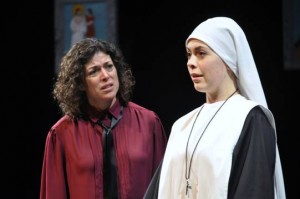
John Pielmeier’s 1980 Agnes Of God is about a battle for a soul — the soul of an illiterate novice nun accused of strangling her new-born baby and depositing the body in a waste basket.
The protagonists are Dr. Martha Livingstone, an edgy chain-smoking psychiatrist assigned by the courts to assess Agnes’s sanity, and the convent’s formidable Mother Superior, a woman determined to protect this child from the outside world and those alien cultures, including shrinks and the courts, which fail to understand that Agnes “belongs to God.”
This is a troublesome play, one that is often vulnerable to its own excesses yet cunning enough in its structure to be able to engage us with a series of dramatic revelations and keep us wondering what will happen next. A superior production can achieve that end — but Kanata Theatre doesn’t quite make the grade. …
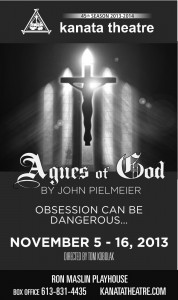 by John Pielmeier
by John Pielmeier
Kanata Theatre
Based on a 1977 case in New York State, Agnes of God by John Pielmeier, first performed in 1980, tells the story of a young novice accused of strangling her baby. The movie version, released in 1985, starred Jane Fonda, Anne Bancroft and Meg Tilly.
In the actual trial, the nun, who, according to the evidence, had apparently been raped by a priest, was found not guilty by reason of insanity.
In Agnes of God, the situation becomes the starting point for pitting faith against science in the form of a battle of words between the Mother Superior at Agnes’ convent and the court-appointed psychiatrist, both of whom carry heavy psychological baggage. …

Review by Dimitri and Vildana Stanisic-Keller
University of Ottawa Drama Guild’s production of Princess T. that runs from October 29th to November 02nd (at 8:00pm) is a richly conceived and daring drama..
Tuesday, opening night, it was close to 7:40pm. when we approached the Academic Hall entrance. There was a sense of confusion due to a locked door with a sign “Silence! The show goes on”. People, spread around as cautious loners, were reading fliers and suspiciously gazing at newcomers. And before you could ask your partner “What’s going on?”, there is a storm of Czech cabaret style clowns (dressed and made-up for Halloween party) surrounding you and whispering “Are you here for Princes T.?”, pulling out some folded paper and thrusting it in your hands. We only glanced at ‘CENSORED’ stamped over the newspaper article with the heading “To ensure peace in the country”.
The psychology of conspiracy is in the air .We don’t say a word but follow them quietly around the building to the back door. The atmosphere of restricted solidarity, boosted by the descent into the catacombesque underground, continues after a door opens and we are back-stage. Quiet, because of the rehearsal that is apparently going on, we look for the next instruction that will tell us what to do. The auditorium is covered with some dirty sheets, except for the first two rows where most seats are marked ‘reserved’. …
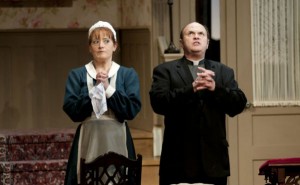
The NAC English Theatre has opened their season with an unusually lively production of Moliere’s TARTUFFE, the play that skewers religious hypocrisy. This is not your father’s TARTUFFE. Very loosely adapted and even more loosely translated by Andy Jones, this version is set in 1939 at the home of a wealthy merchant on the South Coast of Newfoundland. Mr. Jones has retained Moliere’s plot, characters and even his rhyming couplets. The couplets are in the vernacular, which adds to the humor, in particular the incongruities of contemporary slang and sexual references.
Patrick Clark’s sumptuous two-story 1930s set is complete with exterior balconies, other houses silhouetted in the distance and even a laundry line. I especially liked the moose head and portrait of Queen Victoria and the use to which they were put. Rebecca Picharack’s lighting was fine and Marie Sharp’s costumes on the whole excellent, right down to the seams in the ladies’ stockings. Mariane’s black shoes struck a discordant note, but both Elmire’s wig and Act II dress were very good. …